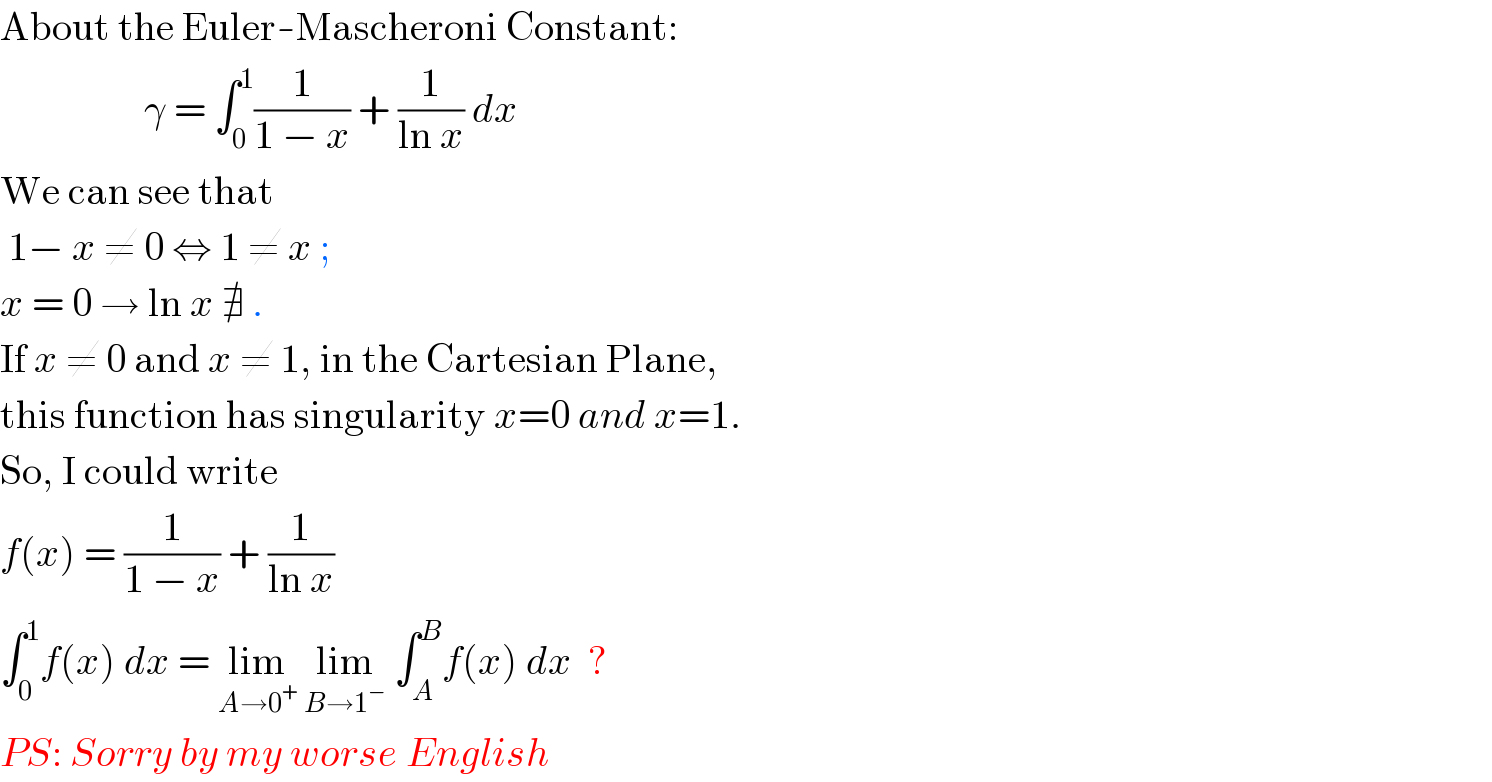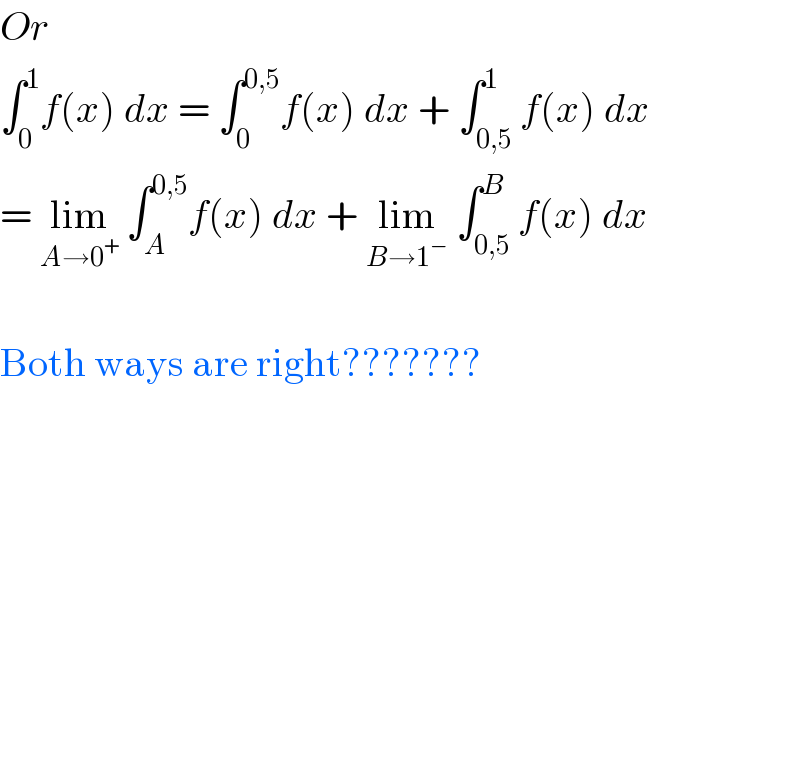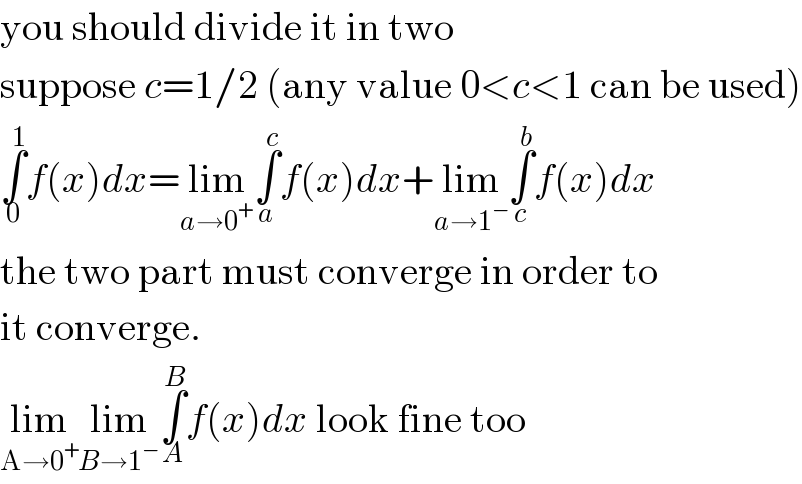
Question Number 9275 by geovane10math last updated on 27/Nov/16

$$\mathrm{About}\:\mathrm{the}\:\mathrm{Euler}-\mathrm{Mascheroni}\:\mathrm{Constant}: \\ $$$$\:\:\:\:\:\:\:\:\:\:\:\:\:\:\:\:\:\:\gamma\:=\:\int_{\mathrm{0}} ^{\mathrm{1}} \frac{\mathrm{1}}{\mathrm{1}\:−\:{x}}\:+\:\frac{\mathrm{1}}{\mathrm{ln}\:{x}}\:{dx} \\ $$$$\mathrm{We}\:\mathrm{can}\:\mathrm{see}\:\mathrm{that}\: \\ $$$$\:\mathrm{1}−\:{x}\:\neq\:\mathrm{0}\:\Leftrightarrow\:\mathrm{1}\:\neq\:{x}\:; \\ $$$${x}\:=\:\mathrm{0}\:\rightarrow\:\mathrm{ln}\:{x}\:\nexists\:. \\ $$$$\mathrm{If}\:{x}\:\neq\:\mathrm{0}\:\mathrm{and}\:{x}\:\neq\:\mathrm{1},\:\mathrm{in}\:\mathrm{the}\:\mathrm{Cartesian}\:\mathrm{Plane}, \\ $$$$\mathrm{this}\:\mathrm{function}\:\mathrm{has}\:\mathrm{singularity}\:{x}=\mathrm{0}\:{and}\:{x}=\mathrm{1}. \\ $$$$\mathrm{So},\:\mathrm{I}\:\mathrm{could}\:\mathrm{write} \\ $$$${f}\left({x}\right)\:=\:\frac{\mathrm{1}}{\mathrm{1}\:−\:{x}}\:+\:\frac{\mathrm{1}}{\mathrm{ln}\:{x}} \\ $$$$\int_{\mathrm{0}} ^{\mathrm{1}} {f}\left({x}\right)\:{dx}\:=\:\underset{{A}\rightarrow\mathrm{0}^{+} } {\mathrm{lim}}\:\underset{{B}\rightarrow\mathrm{1}^{−} } {\mathrm{lim}}\:\int_{{A}} ^{{B}} {f}\left({x}\right)\:{dx}\:\:? \\ $$$${PS}:\:{Sorry}\:{by}\:{my}\:{worse}\:{English} \\ $$
Commented by geovane10math last updated on 27/Nov/16

$${Or}\: \\ $$$$\int_{\mathrm{0}} ^{\mathrm{1}} {f}\left({x}\right)\:{dx}\:=\:\int_{\mathrm{0}} ^{\mathrm{0},\mathrm{5}} {f}\left({x}\right)\:{dx}\:+\:\int_{\mathrm{0},\mathrm{5}} ^{\mathrm{1}} {f}\left({x}\right)\:{dx} \\ $$$$=\:\underset{{A}\rightarrow\mathrm{0}^{+} } {\mathrm{lim}}\:\int_{{A}} ^{\mathrm{0},\mathrm{5}} {f}\left({x}\right)\:{dx}\:+\:\underset{{B}\rightarrow\mathrm{1}^{−} } {\mathrm{lim}}\:\int_{\mathrm{0},\mathrm{5}} ^{{B}} {f}\left({x}\right)\:{dx} \\ $$$$ \\ $$$$\mathrm{Both}\:\mathrm{ways}\:\mathrm{are}\:\mathrm{right}??????? \\ $$$$ \\ $$$$ \\ $$$$ \\ $$$$ \\ $$$$ \\ $$$$ \\ $$$$ \\ $$
Answered by 123456 last updated on 28/Nov/16

$$\mathrm{you}\:\mathrm{should}\:\mathrm{divide}\:\mathrm{it}\:\mathrm{in}\:\mathrm{two} \\ $$$$\mathrm{suppose}\:{c}=\mathrm{1}/\mathrm{2}\:\left(\mathrm{any}\:\mathrm{value}\:\mathrm{0}<{c}<\mathrm{1}\:\mathrm{can}\:\mathrm{be}\:\mathrm{used}\right) \\ $$$$\underset{\mathrm{0}} {\overset{\mathrm{1}} {\int}}{f}\left({x}\right){dx}=\underset{{a}\rightarrow\mathrm{0}^{+} } {\mathrm{lim}}\underset{{a}} {\overset{{c}} {\int}}{f}\left({x}\right){dx}+\underset{{a}\rightarrow\mathrm{1}^{−} } {\mathrm{lim}}\underset{{c}} {\overset{{b}} {\int}}{f}\left({x}\right){dx} \\ $$$$\mathrm{the}\:\mathrm{two}\:\mathrm{part}\:\mathrm{must}\:\mathrm{converge}\:\mathrm{in}\:\mathrm{order}\:\mathrm{to} \\ $$$$\mathrm{it}\:\mathrm{converge}. \\ $$$$\underset{\mathrm{A}\rightarrow\mathrm{0}^{+} } {\mathrm{lim}}\underset{{B}\rightarrow\mathrm{1}^{−} } {\mathrm{lim}}\underset{{A}} {\overset{{B}} {\int}}{f}\left({x}\right){dx}\:\mathrm{look}\:\mathrm{fine}\:\mathrm{too} \\ $$
Commented by geovane10math last updated on 28/Nov/16

$${Thanks}! \\ $$$$ \\ $$
